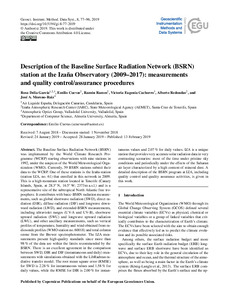Por favor, use este identificador para citar o enlazar este ítem:
http://hdl.handle.net/20.500.11765/10266
Description of the Baseline Surface Radiation Network (BSRN) station at the Izaña Observatory (2009–2017): measurements and quality control/assurance procedures
| Título : | Description of the Baseline Surface Radiation Network (BSRN) station at the Izaña Observatory (2009–2017): measurements and quality control/assurance procedures |
| Autor : | García Cabrera, Rosa Delia

 ; Cuevas Agulló, Emilio
; Cuevas Agulló, Emilio





|
| Palabras clave : | Solar radiation; Radiation measurements; Baseline Surface Radiation Network; Quality control |
| Fecha de publicación : | 2019 |
| Editor: | European Geosciences Union |
| Citación : | Geoscientific Instrumentation, Methods and Data Systems. 2019, 8(1), p. 77-96 |
| Versión del editor: | https://dx.doi.org/10.5194/gi-8-77-2019 |
| Resumen : | The Baseline Surface Radiation Network (BSRN) was implemented by the World Climate Research Programme (WCRP) starting observations with nine stations in 1992, under the auspices of the World Meteorological Organization (WMO). Currently, 59 BSRN stations submit their data to the WCRP. One of these stations is the Izaña station (station IZA, no. 61) that enrolled in this network in 2009. This is a high-mountain station located in Tenerife (Canary Islands, Spain, at 28.3∘ N, 16.5∘ W; 2373 m a.s.l.) and is a representative site of the subtropical North Atlantic free troposphere. It contributes with basic-BSRN radiation measurements, such as global shortwave radiation (SWD), direct radiation (DIR), diffuse radiation (DIF) and longwave downward radiation (LWD), and extended-BSRN measurements, including ultraviolet ranges (UV-A and UV-B), shortwave upward radiation (SWU) and longwave upward radiation (LWU), and other ancillary measurements, such as vertical profiles of temperature, humidity and wind obtained from radiosonde profiles (WMO station no. 60018) and total column ozone from the Brewer spectrophotometer. The IZA measurements present high-quality standards since more than 98 % of the data are within the limits recommended by the BSRN. There is an excellent agreement in the comparison between SWD, DIR and DIF (instantaneous and daily) measurements with simulations obtained with the LibRadtran radiative transfer model. The root mean square error (RMSE) for SWD is 2.28 % for instantaneous values and 1.58 % for daily values, while the RMSE for DIR is 2.00 % for instantaneous values and 2.07 % for daily values. IZA is a unique station that provides very accurate solar radiation data in very contrasting scenarios: most of the time under pristine sky conditions and periodically under the effects of the Saharan air layer characterized by a high content of mineral dust. A detailed description of the BSRN program at IZA, including quality control and quality assurance activities, is given in this work. |
| Patrocinador: | The IZA BSRN program has benefited from results obtained within POLARMOON project funded by the Ministerio de Economía y Competividad from Spain, CTM2015-66742-R. |
| URI : | http://hdl.handle.net/20.500.11765/10266 |
| ISSN : | 2193-0856 2193-0864 |
| Colecciones: | Artículos científicos 2019-2022 |
Ficheros en este ítem:
| Fichero | Descripción | Tamaño | Formato | ||
|---|---|---|---|---|---|
| gi-8-77-2019.pdf | 3,72 MB | Adobe PDF |  Visualizar/Abrir |
Los ítems de Arcimis están protegidos por una Licencia Creative Commons, salvo que se indique lo contrario.





